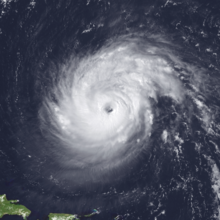 Hurricane Katia near peak intensity well north of the Virgin Islands on September 5 | |
| Meteorological history | |
|---|---|
| Formed | August 29, 2011 |
| Extratropical | September 10, 2011 |
| Dissipated | September 13, 2011 |
| Category 4 major hurricane | |
| 1-minute sustained (SSHWS/NWS) | |
| Highest winds | 140 mph (220 km/h) |
| Lowest pressure | 942 mbar (hPa); 27.82 inHg |
| Overall effects | |
| Fatalities | 3 direct, 1 indirect |
| Damage | $157 million (2011 USD) |
| Areas affected | Lesser Antilles, East Coast of the United States, United Kingdom, France, Germany, Poland, Latvia, Estonia, Russia |
| IBTrACS | |
Part of the 2011 Atlantic hurricane season | |
Hurricane Katia was a fairly intense Cape Verde hurricane that had substantial impact across Europe as a post-tropical cyclone. The eleventh named storm, second hurricane, and second major hurricane of the active 2011 Atlantic hurricane season, Katia originated as a tropical depression from a tropical wave over the eastern Atlantic on August 29. It intensified into a tropical storm the following day and further developed into a hurricane by September 1, although unfavorable atmospheric conditions hindered strengthening thereafter. As the storm began to recurve over the western Atlantic, a more hospitable regime allowed Katia to become a major hurricane by September 5 and peak as a Category 4 hurricane with winds of 140 mph (230 km/h) that afternoon. Internal core processes, increased wind shear, an impinging cold front, and increasingly cool ocean temperatures all prompted the cyclone to weaken almost immediately after peak, and Katia ultimately transitioned into an extratropical cyclone on September 10.
Although Katia passed well north of the Lesser Antilles, a yellow alert was hoisted for Guadeloupe to notify residents of dangerous seas. Strong rip currents along the East Coast of the United States led to the deaths of two swimmers. After losing its tropical characteristics, Katia prompted the issuance of numerous warnings across Europe. Hurricane-force winds impacted numerous locations, downing trees, toppling power poles, and leaving thousands without electricity. The storm was responsible for two deaths in the United Kingdom: one when a tree fell on a vehicle in County Durham, and another during a multi-car accident on the M54 motorway resulting from adverse weather conditions. The post-tropical cyclone caused approximately £100m ($157 million, 2011 USD) in damage in the United Kingdom alone.